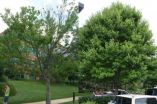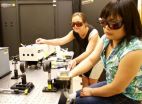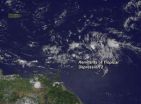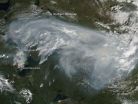(Press-News.org) New research from North Carolina State University shows that urban "heat islands" are slowly killing red maples in the southeastern United States. One factor is that researchers have found warmer temperatures increase the number of young produced by the gloomy scale insect – a significant tree pest – by 300 percent, which in turn leads to 200 times more adult gloomy scales on urban trees.
"We'd been seeing higher numbers of plant-eating insects like the gloomy scale in cities, and now we know why," says Adam Dale, a Ph.D. student at NC State and lead author of two papers describing the work. "These findings also raise concerns about potential pest outbreaks as temperatures increase due to global climate change."
Gloomy scales suck sap from trees, removing nutrients and energy. This reduces tree growth and can eventually kill trees.
The researchers focused specifically on the abundance of gloomy scales on red maple (Acer rubrum) trees at 26 sites in Raleigh, North Carolina. "We wanted to look at the most important pest species of the most common tree species in urban areas of the southeastern United States," says Dr. Steve Frank, an assistant professor of entomology at NC State and senior author of the papers.
Urbanization reduces the amount of vegetation in a habitat and increases impervious surfaces such as roads and rooftops. This can diminish predator and parasitoid communities and their ability to control pests. However, it also makes cities hotter than rural areas. The researchers collected data on a wide variety of ecological variables that could affect gloomy scale populations, including habitat characteristics, the temperature at each tree site, and the abundance of predators and parasitoids.
"Temperature was the most important predictor of gloomy scale abundance – the warmer it was, the more scale insects we found," Dale says. "The other variables we looked at had no significant effect on gloomy scale abundance." The researchers also found that temperatures were related to the amount of impervious surfaces in the area, including streets, sidewalks, and parking lots. In short, the higher the percentage of impervious surfaces, the warmer the area.
Gloomy scales reproduce only once per year, giving birth to live young. So Dale collected gloomy scales at each site he was monitoring and dissected them to see how many young they were about to produce.
"At the coolest sites – 18.26 degrees Celsius (64.87 Fahrenheit) – the females were producing approximately 20 young," Dale says. "At the warmest sites – 20.12 degrees Celsius (68.22 Fahrenheit) – the females were producing around 60 young. That supports the differences we saw in scale insect abundance on the trees. Populations at the warmest sites were over 200 times more abundant than those at the coolest sites."
"We don't know all of the variables that contribute to the higher abundance, but higher reproduction rates are clearly part of the picture," Frank says. "When we look at abundance, we're looking at an accumulation of generations of scales."
The researchers also found a second factor in urban heat's adverse impact on red maples. Specifically, the researchers found that higher temperatures increase stress on red maples by making it harder for them get water from their roots to their leaves.
To get a sense of the overall impact of heat on red maples, the researchers evaluated the condition of 2,780 trees in Raleigh, North Carolina, and compared the condition against a heat map of the city.
"This work tells us that urban planners and foresters may need to change the way they decide which trees to plant, and select trees that are better suited to hotter conditions," Dale says.
"This also tells us that we need to plant more trees and vegetation in cities, increasing shade on impervious surfaces and limiting the 'heat island' effect," Frank says. "It would also make sense to choose trees that are less susceptible to scales and other pest species."
The research on scale insect abundance is published in "Urban warming trumps natural enemy regulation of herbivorous pests," which is forthcoming from the journal Ecological Applications. The research on the overall impact of urban heat on red maples is in "The effects of urban warming on herbivore abundance and street tree condition," which was published in PLOS ONE on July 23.
The Ecological Applications study's findings are also consistent with an earlier study from Frank's lab that found another scale insect species is more abundant at warmer temperatures due to increased survival rates.
"This work makes us think that increasing urbanization and rising temperatures associated with global climate change could lead to increases in scale insect populations, which could have correspondingly negative effects on trees like the red maple," Dale says.
INFORMATION:
The work was supported by the Department of the Interior's Southeast Climate Science Center, which is based at NC State and provides scientific information to help land managers respond effectively to climate change. The project was also supported by Agriculture and Food Research Initiative Competitive Grant number 2013-02476 from the USDA National Institute of Food and Agriculture.
Urban heat boosts some pest populations 200-fold, killing red maples
2014-07-23
ELSE PRESS RELEASES FROM THIS DATE:
NASA sees Typhoon Matmo making second landfall in China
2014-07-23
NASA's Terra satellite passed over Typhoon Matmo when it was moving through the Taiwan Strait for its final landfall in mainland China.
On July 23 at 02:45 UTC (July 22 at 10:45 p.m. EDT), the Moderate Resolution Imaging Spectroradiometer or MODIS instrument aboard NASA's Terra satellite captured a picture of Typhoon Matmo after its center crossed the northern part of the island nation of Taiwan and entered the Taiwan Strait. The Taiwan Strait is the body of water between western Taiwan and southeastern China. The MODIS image showed a cloud-covered center of circulation, ...
Targeting the brain to treat obesity
2014-07-23
Unlocking the secrets to better treating the pernicious disorders of obesity and dementia reside in the brain, according to a paper from American University's Center for Behavioral Neuroscience. In the paper, researchers make the case for treating obesity with therapies aimed at areas of the brain responsible for memory and learning. Furthermore, treatments that focus on the hippocampus could play a role in reducing certain dementias.
"In the struggle to treat these diseases, therapies and preventive measures often fall short. This is a new way for providers who treat ...
UNC researchers find unsuspected characteristics of new CF drugs, offering potential paths to more effective therapies
2014-07-23
In lab experiments using tissue samples cultured from cystic fibrosis patients, scientists at the UNC School of Medicine and the UNC Marsico Lung Institute have shown that a new CF drug counteracts the intended beneficial molecular effect of another CF drug.
The finding, published today in the journal Science Translational Medicine, shows how a mutant CFTR protein becomes unstable and loses its ability to function properly when in the presence of the two drugs. The research offers several insights into how novel CF pharmacotherapies could be improved.
“In our human ...
Spinach could lead to alternative energy more powerful than Popeye
2014-07-23
WEST LAFAYETTE, Ind. — Spinach gave Popeye super strength, but it also holds the promise of a different power for a group of scientists: the ability to convert sunlight into a clean, efficient alternative fuel.
Purdue University physicists are part of an international group using spinach to study the proteins involved in photosynthesis, the process by which plants convert the sun's energy into carbohydrates used to power cellular processes.
"The proteins we study are part of the most efficient system ever built, capable of converting the energy from the sun into chemical ...
The birth of topological spintronics
2014-07-23
The discovery of a new material combination that could lead to a more efficient approach to computer memory and logic will be described in the journal Nature on July 24, 2014. The research, led by Penn State University and Cornell University physicists, studies "spin torque" in devices that combine a standard magnetic material with a novel material known as a "topological insulator." The team's results show that such a scheme can be 10 times more efficient for controlling magnetic memory or logic than any other combination of materials measured to date.
"This is a really ...
Strategy proposed for preventing diseases of aging
2014-07-23
AUDIO:
Some researchers are proposing that changing how medical care is delivered could help prevent multiple chronic diseases and extend healthy lifespan. The idea, they argue, would be to target the...
Click here for more information.
Medicine focuses almost entirely on fighting chronic diseases in a piecemeal fashion as symptoms develop. Instead, more efforts should be directed to promoting interventions that have the potential to prevent multiple chronic diseases and extend ...
Sleep deprivation may increase susceptibility to false memories
2014-07-23
Not getting enough sleep may increase the likelihood of forming false memories, according to research published in Psychological Science, a journal of the Association for Psychological Science.
In a study conducted by psychological scientist Steven J. Frenda of the University of California, Irvine and colleagues, sleep-deprived people who viewed photographs of a crime being committed and then read false information about the photos were more likely to report remembering the false details in the photos than were those who got a full night's sleep.
Research has demonstrated ...
Satellite shows Atlantic Tropical Depression degenerate
2014-07-23
NOAA's GOES-East satellite captured imagery of the Atlantic Ocean's Tropical Depression 2 is it degenerated into a tropical wave on July 23.
At 1445 UTC (10:45 a.m. EDT), NOAA's GOES-East satellite captured an image of what was once Tropical Depression 2 (TD2), about 400 miles east of the Lesser Antilles. The GOES-East visible satellite imagery indicated that the depression weakened since July 22. TD2 appeared as just a weak swirl of clouds with no strong thunderstorms or deep convection. The GOES image was created by NASA/NOAA's GOES Project at NASA's Goddard Space Flight ...
Gene inhibitor, salmon fibrin restore function lost in spinal cord injury
2014-07-23
Irvine, Calif., July 23, 2014 — A therapy combining salmon fibrin injections into the spinal cord and injections of a gene inhibitor into the brain restored voluntary motor function impaired by spinal cord injury, scientists at UC Irvine's Reeve-Irvine Research Center have found.
In a study on rodents, Gail Lewandowski and Oswald Steward achieved this breakthrough by turning back the developmental clock in a molecular pathway critical to the formation of corticospinal tract nerve connections and providing a scaffold so that neuronal axons at the injury site could grow ...
Fires in the Northern Territories July 2014
2014-07-23
Environment Canada has issued a high health risk warning for Yellowknife and surrounding area because of heavy smoke in the region due to forest fires. In the image taken by the Aqua satellite, the smoke is drifting eastward along normal wind patterns. Fire is an obvious health hazard, but the smoke that comes from fires is not quite so obvious and its effects are insidious.
The smoke released by any type of fire (forest, brush, crop, structure, tires, waste or wood burning) is a mixture of particles and chemicals produced by incomplete burning of carbon-containing ...







